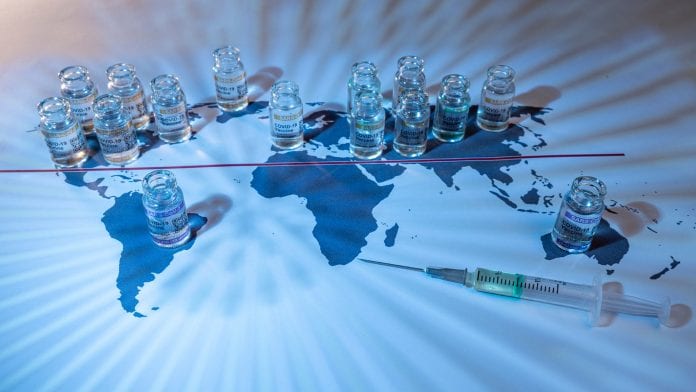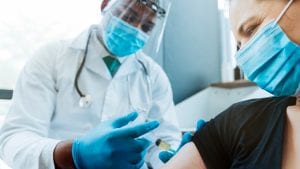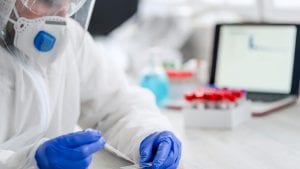
Akshaya Kumar, Director of Crisis Advocacy at Human Rights Watch, speaks to us about intellectual property and vaccine inequity.
In October 2020, representatives of India and South Africa submitted a proposal for a waiver of the Trade Related Intellectual Property Rights (TRIPS) agreement to the World Trade Organization (WTO). The proposed TRIPS waiver would enable manufacturers to produce COVID-19 vaccines, as well as other medical equipment which is necessary to combat the pandemic and treat patients with the virus, without the need to source potentially costly licences from the intellectual property (IP) holders – however, to date many policymakers around the world have expressed opposition to the scheme. Akshaya Kumar, Director of Crisis Advocacy at Human Rights Watch, speaks to Health Europa Quarterly (HEQ) about the hazards of restricting IP during a global healthcare crisis and the need to shore up equal distribution of vaccines.
What are the risks posed by unequal vaccine distribution?
We see a whole range of risks – to the economy; to our societies; and there are also serious public health and human rights risks, because no-one in this world is going to be safe unless we have vaccines made available to everyone who wants one and who needs that protection. Right now, with the situation of vaccine inequity that we are facing, we are going to effectively have two pandemics: the wealthier worlds which have had privileged and priority access to COVID-19 vaccines will experience an artificial sense of security, because they are essentially in a bubble; while the pandemic continues to rage in the developing world. That is why we as human rights organisation have stepped into this issue, because we worry that global vaccine inequities are going to potentially create a gulf between our societies as well.

How does a TRIPS waiver work and what benefits would it offer in the case of COVID-19 vaccines and associated medical products?
The TRIPS waiver which has been proposed by India and South Africa would cover COVID-19 vaccines, diagnostics and therapeutics: the whole life cycle, from testing to treatment to prevention. The idea is that certain rules of the World Trade Organization which make it harder for factories in the developing world to pitch in and begin manufacturing would be waived until everyone everywhere has access to vaccination. It is a time-bound waiver, but rather than being in effect for a certain number of months it would be based on a condition: once we get to the point that everyone has access to vaccines, the intellectual property rights that are protected through the WTO’s agreement would come back into effect.
What that means in practice is that right now, we know that we have a huge demand for vaccines and not enough to go around; and so there have been a lot of arguments about how to better prioritise who should come first. Is it right that a 15-year-old or even a 13-year-old in New York, where I live, is able to get a vaccine, while a doctor who is working on the frontlines in a country like Haiti or Burkina Faso is not? That is an important conversation to have, but we would be in a much better position if we just had to ration less. That is what this waiver would do: it would unlock the potential for us to be in a place where we would be rationing less, instead of fighting about how to ration better. This could not be done single-handedly and it could not be accomplished overnight, but what it would mean is that factories and producers in countries which need vaccines and are currently importing them would be able to begin to scale up production without needing to obtain permission from the originator or the company which currently holds the IP.
We know that there are some factories which want to pitch in. Incepta Pharmaceuticals in Bangladesh has said: we have a factory here, we have made vaccines before, we are ready to chip in; all we need is either the permission or the assurance that if we move forward, we will not to be sued or prevented from exporting our drugs. It has not received either the permission from AstraZeneca, Johnson and Johnson or even the University of Oxford; and so it is just waiting in limbo because no-one wants to do a voluntary deal. That is part of the problem right now: some European leaders are saying that voluntary licencing is the way forward and that these companies will engage in voluntary licences; but we are seeing that, as they have been negotiated to date, voluntary licences tend to be extremely limited. We have one in place with the Serum Institute of India, but the Serum Institute has now said that it will not begin exporting vaccines until the end of 2021 because of the need in India, so that plan will only serve one country – and what about the rest of the world?

While US President Joe Biden has now expressed a qualified degree of support for a TRIPS waiver, many other world governments still seem to be broadly opposed. What reasons have governments given for this?
It was a huge difference for the US government to come out in favour of this waiver – and its support is limited or qualified in the sense that it has focused specifically on vaccines and excluded from its support the idea of waiving IP around other medical products, such as personal protective equipment (PPE), the bioreactor bags that are needed to make the vaccines, tests and diagnostics; and we think all of that needs to be included.
There are three main reasons that governments have opposed a TRIPS waiver. The first is that they say the current system is good enough and manufacturers should just try to use the flexibilities which are already outlined in the TRIPS agreement, but what we have seen in the past is that those flexibilities are really hard to use. There is a Canadian company which is currently trying to use the flexibilities to get access to the formula to make vaccines to export to Bolivia: the Bolivian authorities have said that they want those vaccines, they do not have a better source, and they are ready to issue a compulsory licence; and they have notified the WTO of this. Everyone is dotting all the Is and crossing all the Ts, and yet they still have not got the support that they need from the Canadian government, because that particular vaccine is not listed on Canada’s national list of products that could be waived. As you can see, using these flexibilities is incredibly challenging; and if there were a waiver, then we would not have to worry about whether each and every single I was dotted and every T was crossed – we would be able to move expeditiously in response to the real scale of the pandemic that we are facing.
The other main objection comes from the suggestion that pharmaceutical companies are innovators and they should be compensated for their innovation, because if they were not, they would not be motivated to continue to innovate. There are two principal responses to that: one is that the waiver itself still allows for some compensation, which could be adequate. The second point, and this is more important, is that most of these vaccines were publicly funded. The vast majority of funding and resources went into producing many of the COVID-19 vaccines – in some cases, essentially all of it – was provided by governments, so it is not a case where scientists within a pharmaceutical company laboured on their own for years and the company fronted all of that innovation cost. In this case, governments came together and subsidised that innovation up front; but then, because of how the system is, the innovation was still credited fully to the companies without any recognition of that public support.
The last objection – and I think this one is slightly condescending – is basically the idea that, if we let factories in places like Bangladesh or South Africa begin to make the vaccine from A to Z, we are not sure about the safety of what they produce; the vaccines may not be as high quality as those produced in a factory in Belgium. That line of thinking is quite troubling, because it effectively writes off billions of people – whole swathes of the world – as just being inadequate, without really testing that hypothesis. We should be much more specific in that kind of criticism, rather than suggesting that there are only 12 factories in the world that can make these vaccines. They are not that sophisticated; in fact, the whole theory behind mRNA is that vaccines can be made in smaller batches because the bioreactors have to be smaller. This means that it would make sense to have more and smaller factories closer to where people who are using them need to be, instead of the system that we have now, which is that a very small number of companies have huge factories with lots of bioreactors in them.
How do IP laws and patents on medicines affect the availability of vaccines, particularly in lower-income regions?
As a human rights advocate, we have seen some of this story before with the AIDS movement, where there were – and still are – huge gaps in access to treatment. There has been a conversation around access to insulin; some of these issues are definitely reproduced across more endemic diseases, but what is special about the pandemic that we are now facing is that never before have we had the ambition to try to vaccinate 7.7 billion people, including adults, as quickly as possible in a 12- to 18-month time frame. We need to think more creatively, we need to think outside the box; and the faster we move, the better – because there is also the risk of mutation and variants leading to the potential development of vaccine-resistant strains.

Is there an element of needing to maintain that momentum to avoid stagnating or becoming complacent with this rate of progress?
Absolutely. We are experiencing a real moment where this conversation is coming into the mainstream: Trevor Noah has covered it; Russell Brand has covered it – there is now a conversation happening about exactly how drugs, vaccines and tests are made available to people. The more that these issues can be vernacularised, the more people can understand how these issues connect to their daily lives, as they do with the case of the pandemic; the better it is for real policy movement and change. In the past this has been the provenance of technical experts, but now almost everyone can say: I understand that; I’ve been able to get my jab – why should a doctor somewhere else still be waiting?
How can post-pandemic recovery measures address systemic health inequality and protect citizens and public funds from exploitation?
A lot of what we do now will set the tone for when a post-pandemic recovery takes place and on what scale it will be, whether it happens equitably at the same time or some parts of the globe will be left fending for themselves for much longer. We have a recognition that we are all in a very similar storm but in different boats; and the absence of adequate social safety nets, along with the need to consider the ways in which lack of universal health coverage has exacerbated this pandemic in many parts of the world, have really drawn links between historic weaknesses in public health systems and vulnerabilities to these emerging issues like the onset of a global pandemic. From a human rights perspective, if you centre the right to health as a part of planning for post-pandemic recovery, then you have to do that in a holistic way that looks at social safety nets; that looks at universal healthcare and coverage; that looks at access to medicines; and that builds all of those factors into the system. The other key factor is the big conversation which is ongoing around debt restructuring, because that also fits into the global inequity picture.
Right now, this negotiation is ongoing. It seems as though Europe, particularly the European Commission, is holding the line for pharmaceutical companies, but the European Parliament has recently passed a resolution expressing majority support for the waiver in the form of an amendment to a resolution about AIDS – this points to the broader issue, which is that this is all connected. We have the public and parliamentarians making demands now. The Pope has weighed in; Prince Harry and Meghan, the Duke and Duchess of Sussex, have weighed in. We do have this popular discourse around the issue, but the technical arguments that are still carrying the day are the ones being made by the European commissioners. It will be interesting to watch how Europe grapples with that gap between the perspective that is bubbling up within civil society and the very hard line that is being taken at the top by the bureaucrats in the European Commission.
Akshaya Kumar
Director of Crisis Advocacy
Human Rights Watch
www.hrw.org
This article is from issue 18 of Health Europa. Click here to get your free subscription today.

























